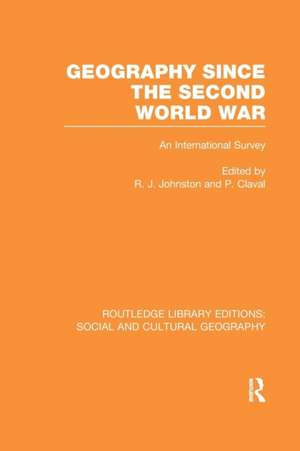Geography Since the Second World War: Routledge Library Editions: Social and Cultural Geography
Editat de Ron Johnston, Paul Clavalen Limba Engleză Paperback – 21 ian 2016
| Toate formatele și edițiile | Preț | Express |
|---|---|---|
| Paperback (1) | 416.22 lei 6-8 săpt. | |
| Taylor & Francis – 21 ian 2016 | 416.22 lei 6-8 săpt. | |
| Hardback (1) | 821.94 lei 6-8 săpt. | |
| Taylor & Francis – 4 dec 2013 | 821.94 lei 6-8 săpt. |
Preț: 416.22 lei
Nou
Puncte Express: 624
Preț estimativ în valută:
79.65€ • 83.43$ • 66.01£
79.65€ • 83.43$ • 66.01£
Carte tipărită la comandă
Livrare economică 09-23 aprilie
Preluare comenzi: 021 569.72.76
Specificații
ISBN-13: 9781138975125
ISBN-10: 1138975125
Pagini: 314
Dimensiuni: 156 x 234 x 16 mm
Greutate: 0.45 kg
Ediția:1
Editura: Taylor & Francis
Colecția Routledge
Seria Routledge Library Editions: Social and Cultural Geography
Locul publicării:Oxford, United Kingdom
ISBN-10: 1138975125
Pagini: 314
Dimensiuni: 156 x 234 x 16 mm
Greutate: 0.45 kg
Ediția:1
Editura: Taylor & Francis
Colecția Routledge
Seria Routledge Library Editions: Social and Cultural Geography
Locul publicării:Oxford, United Kingdom
Public țintă
General, Postgraduate, Professional, and UndergraduateCuprins
1. Introduction: The International Study of the History of Geography 2. France 3. Italy 4. South-east Euorpe 5. The Soviet Union 6. The United Kingdom 7. Poland 8. The German-speaking Countries 9. North America 10. Human Geography in the Netherlands 11. Japan 12. The Iberian Peninsula and Latin America 13. Conclusion.
Notă biografică
Multivolume collection by leading authors in the field
Descriere
The discipline of geography has undergone much change and growth in recent years. With growth has come diversity. Before 1945 there were differences between countries in the emphases on subject matter and research approach, although these were all related closely to three main ‘models’ – French, German and American. Since then, the relative importance of French and German influences has declined substantially, including within their own national territories, and the Anglo-American model has grown to world dominance. With that model, however, there is no dominant point of view but rather a multiplicity of competing approaches. These various approaches have had a different reception in other parts of the world, reflecting the base of pre-1945 geographical scholarship, the goals of geographical work set by soceities and the nature of the international contacts. The result is substantial international diversity in the practice of geography.





































